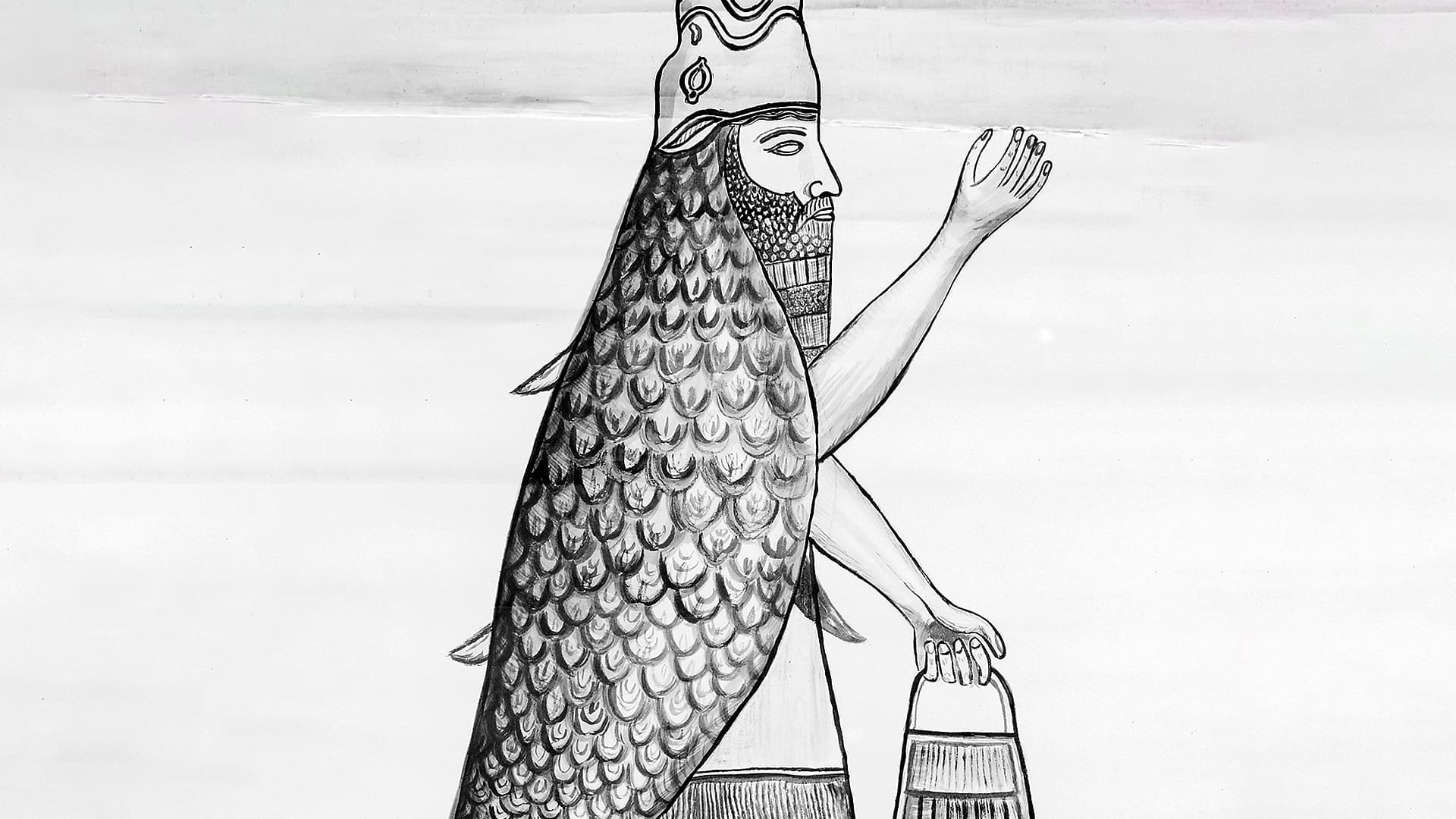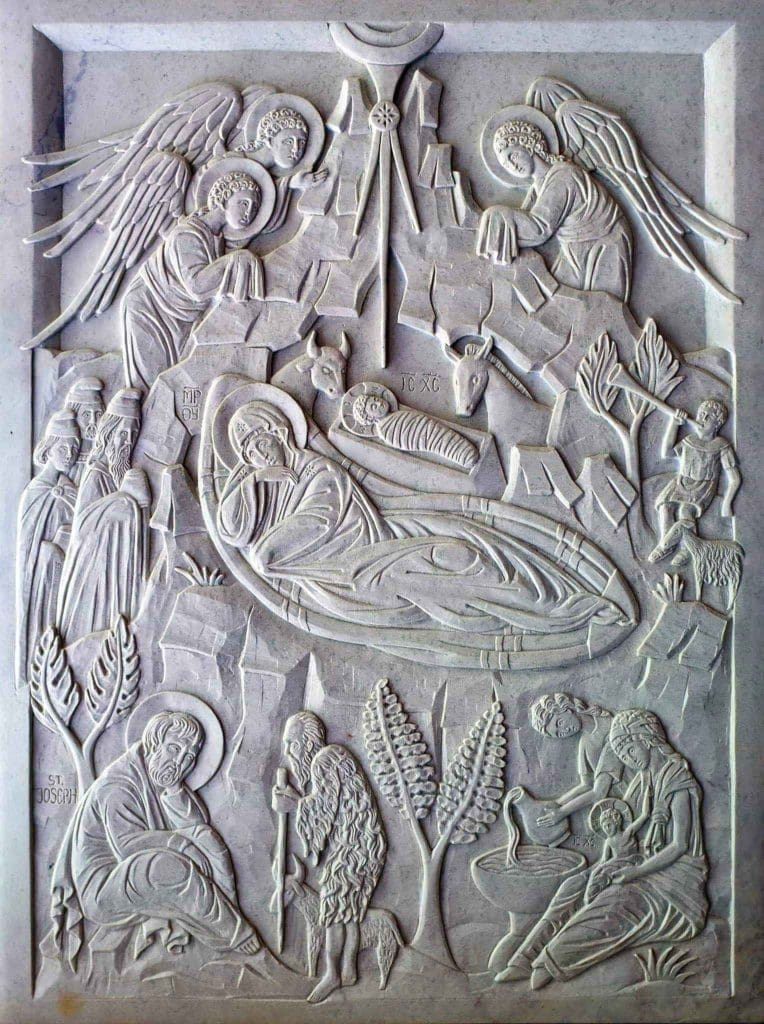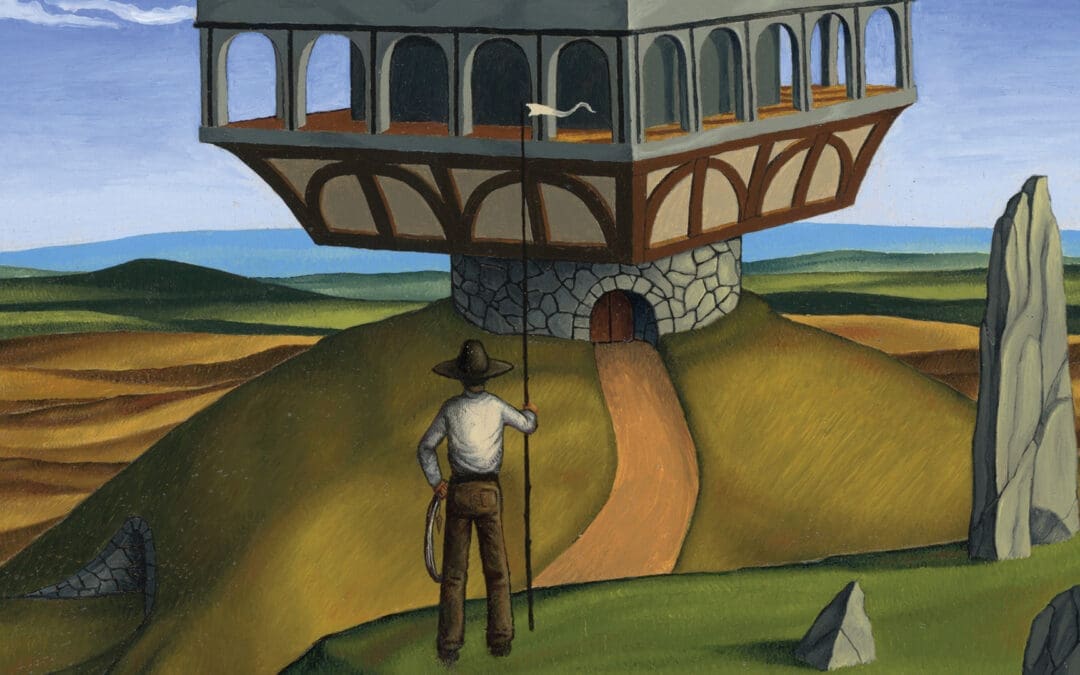B
But when they rose early on the next morning,
behold, Dagon had fallen face downward on the
ground before the ark of the LORD.
(1 Samuel 5:4)
Though the Philistines had never seen Raiders of the Lost Ark, they knew enough about the God of their enemy to be afraid. After a sharp repulse, rather than retreating from the field of battle, the Israelites sent men to Shiloh to fetch back their secret weapon, the ark of the covenant. Inside this golden chest, a container so holy even the priests of the Almighty dared not touch it, were the stone tablets on which the fingertip of God had inscribed his law. Despite the recent defeat, when Hophni and Phineas, the unreliable sons of the high priest Eli, arrived in camp with the ark, a cry of triumph filled the air. It was loud enough to shake the earth, the story says, and to shake Philistine confidence, too.
They knew all about the Hebrew God, how he’d freed his people from Egyptian bondage through terrible plagues. Smiting the Israelites was one thing. Smiting them under the very nose of their God was something else entirely. Sensing fear in the ranks, the Philistine leaders admonished their soldiers to “be men and fight.”
Fight they did, with disastrous results for Israel. Thirty thousand fell in the battle, including Hophni and Phineas. The Philistines captured the ark and took it back to Ashdod—one more trophy to deposit in the temple of their own god, Dagon.
When Eli heard, the high priest fell backward in his chair and broke his neck. The pregnant wife of slain Phineas named her newborn child Ichabod. “The glory,” she said, “has departed from Israel!”

For as long as men marched into battle arrayed in lines, they rallied to standards—flags and banners, regimental colours—which not only served as markers in the smoke, but symbolized the power and honour of the armies themselves. The legions of Rome marched with an imperial eagle at their head, as did the musket-wielding armies of the Emperor Napoleon.
In the HBO series Rome, for example, Lucius Vorenus and Titus Pullo make a name for themselves by recovering the lost eagle of Julius Caesar, filched by some woad-daubed Gauls. As a symbol, the eagle’s loss implies Roman weakness. To reassure friend and foe alike of Caesar’s undiminished strength, Vorenus and Pullo must take the eagle back. A similar dilemma drives the hero of Rosemary Sutcliffe’s classic adventure novel The Eagle of the Ninth—not to mention Bernard Cornwell’s Richard Sharpe, who can only restore the honour of his regiment after the loss of its own colours by snatching one of Napoleon’s eagles on the field of Talavera.
But Israel had lost more than a battle standard. The capture of the ark represented not just Hebrew weakness or dishonour. For this tabernacle-centred culture, the ark conveyed divine presence, which meant the servants of Dagon had defeated Yahweh on the field, demonstrating which of the two gods reigned supreme. Now the ark sat at Dagon’s right hand. No Hebrew Vorenus and Pullo waited in the wings to recapture the ark and restore God’s prestige. The glory had not only departed, it was irretrievably lost.
In hindsight, the Israelites must have regretted exposing the ark to such danger. Better to keep it safely tucked away at Shiloh than risk losing it altogether. In this belief, however, they were mistaken.
The ark had an agenda of its own. No Israelite army on its own strength could have penetrated deep into Philistine land to install the ark inside the temple of Dagon. Only God could do such a thing, and he could do it without their help. Later God would propagate the faith by sending his missionaries to the four corners of the earth as humbled captives, turning defeat and diaspora to good ends, and the Roman beast would draw the Gospel close to its breast by exercising its powers of arrest. Likewise, the ark needed no human strength, no protection from the threat of the outside world. If only the Israelites had realized, there was nowhere the ark could be taken where creation would not welcome it.
In the temple of Dagon, strange things began to happen.
Shaped from stone, the central idol in the temple depicted a deity who was half-fish, halfman. Surviving images resemble a mermaid with a curly Sumerian-style beard. The biblical account does not refer to this idol as an idol—or, as we might, a statue. The idol and the god are treated as synonymous. The ark sat “beside Dagon.” The stone idol itself was the object of Philistine worship. To pray to Dagon, one prayed to the stone.
So imagine the dismay of Dagon’s attendants when they entered and found that during the night, Dagon had tipped over, landing on his face before the ark of the covenant. They quickly righted him, trying not to dwell on any symbolism inherent to the scene. But a sense of unease must have filled their hearts.
The next morning, the same drama repeated itself, only this time Dagon landed with such force that his head and hands snapped off on the temple’s threshold. So traumatic was the sight that, forever after, the worshippers of Dagon stepped clear of the threshold when they entered the temple in Ashdod.
The ark, it seemed, had needed no rescuers after all. Following the fall of Dagon, a plague descended on the Philistines. For seven months, they shifted the ark from one location to the next, disease following at its heels, until the Philistines themselves handed it back—along with a guilt offering to make amends. While the Israelite army was defeated in battle, their God with no army brought the enemy to its knees.
As a child hearing this story for the first time in church, my ears pricked up. During most sermons, I tended to pass time by flipping to the back of my zippered Bible and perusing the maps. But the thought of these nightly skirmishes in the temple of Dagon fired my imagination. I envisioned the nervous idol marking the sun’s descent through one of the temple’s stone windows, reluctant to be left alone with the ark of the covenant, though unable to confide his fears. He was stone, after all, and could not speak.
Then the sun would fall and the golden cherubim atop the ark would limber their wings. With a flash of gold in the darkness, they would ascend to Dagon’s shoulders, take hold, and cast the false god down. In my mind, the two nights compressed into one. After the first face plant, Dagon struggles to his feet. The cherubim fling him to the ground a second time, shattering his appendages.
“—And stay down,” the angels say.
Dagon knows better than to rise a third time.
This is how the battle is too often envisioned, a Manichean struggle between light and dark, between the true deity and the false one. But there is another possibility, another way of answering the burning question: “What made Dagon bow?”
Before Dagon, there was the stone.
Men quarried the stone, cutting it out of the earth and transporting it by cart into the cities, where it was used to pave roads and build walls. They put the stone to every imaginable purpose, stacking and shaping, carving and mortaring, constructing houses and marketplaces, theatres, even temples. The stone served as raw material for human hands to form. And one of the things they formed was the image of Dagon.
Stone, of course, does not stop being stone just because men have shaped it into something else. There are properties intrinsic to rocks that won’t go away. The poor Philistines had learned this lesson earlier, during the time of the judges, when they dragged blind Samson into another of Dagon’s temples and let him rest against the pillars supporting the roof. They had formed the stone into a building sturdy enough to support the weight of three thousand people on its roof, but with a push Samson freed the rock of its man-made shape and the stone did what stone does: It fell right down. More people were killed by Samson in that one instance than in the whole of his life, and yet he never laid a hand on any of them. Gravity and the stone did all the work.
If we can separate the stone from its form, the raw material of creation from the shape human hands have given it, another way of seeing Dagon’s fall emerges. Perhaps, as in Samson’s case, the stone was merely doing what stone does.
In Luke’s Gospel, the account of Christ’s triumphal entry to the city of Jerusalem includes a detail that might shed light on what happened over those successive nights in Ashdod. As Jesus rides in, the crowds throw palm leaves in his path and sing hosannas. This is bad, as the religious leaders on the scene are quick to note. The people are offering worship to Jesus, a man, which is tantamount to idolatry. As Paul would write in Romans 1, idolators “worship and serve the creature rather than the Creator,” and here were people doing precisely that, worshipping a fellow human being when they ought to worship God alone. Surely the Jews lining the road into Jerusalem were no better than the Philistines kneeling before the stone idol in Ashdod.
The response Jesus makes is telling. “If these [people] were silent,” he says, “the very stones would cry out.”
If responding to the pull of gravity is one characteristic of stone, Jesus here reveals another, unexpected, property: Stone will worship. All creation, as Paul writes in Romans 8, groans in expectation of deliverance. Jesus, the incarnate God, would be worshipped that day on the road into town, and if humanity would not do the job, the stone would. Creation was not going to stand by and let the Christ enter unheralded.
Jesus might have singled out the trees or the wind or the donkey he rode on, but the stone was particularly à propos. Stone is inanimate, inert. It has no life. The dead heart in Ezekiel’s vision of quickening, the one replaced by the heart of flesh, is made of stone. We do not expect stone to do anything. Even in Samson’s case, the stone is acted upon, not acting. Jesus called on the stone because it was the least likely thing to take action. To say that the stone would cry out implies creation’s extreme umbrage at the thought of human silence.
It was as if he’d turned to the Pharisees and said, “Even the rocks know better than you.”
It is commonplace to think of human creativity as transformative. We take one thing and make it into another. Those of us who are Christian interpret this creativity as a consequence of our createdness. Since we are made in the image of a God who reveals himself first and foremost as a creator, is it any wonder that we, too, are creators, albeit on a smaller scale? The experience of human creativity can even serve as a window into the mind of God, as it does for Dorothy Sayers in The Mind of the Maker. If you want to understand what things must be like from God’s perspective, think of a novelist and the characters she creates by way of analogy.
Speaking as a novelist, however, the metaphor has its limits. I may invent characters and place them in an imaginary world, but this is nothing like creation ex nihilo, any more than the writers on HBO’s Rome or Rosemary Sutcliffe or Bernard Cornwell conjured the significance of a lost eagle out of thin air. We quarry pre-existing cultural stone just as the men who formed the idol of Dagon did, giving shape to the material of history and thought. Despite the grousing of history buffs everywhere, a movie that gives a misleading form to the facts doesn’t alter the history itself. What happened is still what happened. Our ability to transform, impressive as it is, knows certain limits. We can’t make bricks without straw. Instead of connecting our creativity to the Creator, it might be better to link ourselves to the original image-bearer, Adam. Set down in the middle of a garden he did not plant, he was tasked with the job of cultivation. He named things. He tended things. Out of creation, he began to form culture. True, he exercised an incredible power over the rest of the things God made, so much so that his sin brought the whole of creation under corruption’s sway. And yet, the names he gave things didn’t change the things themselves. In the act of naming, he probably tried to match the reality inherent to the things by virtue of their createdness.
Creation and ownership go hand in hand. What you make belongs to you, both physically and teleologically. If you make it, you have the power to say what it’s for. Human creativity, however, feels incomplete in this regard. Even though I can tell you what the story I invent is supposed to be about, there are other themes, other meanings already embedded in the cultural material. My process of borrowing smuggles them in and I tend to get the credit, whether I deserve it or not. As an artist, I am not in absolute control over the meaning of my art. Like a gardener, I work with living material. I did not give it life, and thus cannot anticipate the direction in which every tendril and sprout will grow.
The men who fashioned the idol of Dagon which sat in the temple at Ashdod experienced a similar lack of authority. Although they had authored the idol, they did not author the stone and lacked the power to change what it was. The rock itself, their raw material, retained its createdness. Why did Dagon bow? Perhaps because in the presence of the ark, carrying inside it the testament of the living God, the stone Dagon was made of could do no less. Freed from the form men had given it, the stone did what Christ says stone will do when human lips are silent—it offered worship. Twice the narrative in 1 Samuel 5 makes a point of reporting that Dagon fell face down. In other words, he bowed, prostrating himself in an attitude of supplication. My childhood imaginings notwithstanding, no vengeful cherubim were required to perform the operation.
Defying the idolatrous shape imposed on it, undermining the strength of Dagon from within, the stone fell down and worshipped.
There would have been no call for Israelites to expect that in the temple of Dagon, the true God would find worshippers, any more than faithful readers expect to find evidence of grace in the cultural work of those who do not know grace. They imagined, just as we imagine, that there are dark places in this world into which the light dares not enter, that there are borders we might cross and thus pass out of God’s realm.
There is, however, no square inch of creation over which Christ does not claim ownership. He made it all and he will hold on to it, even on a dark night in Ashdod, within the inner sanctum of his supposed rivals. Wherever he goes, worshippers await him. And wherever we go, he is there already, and has been since the world began.








